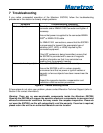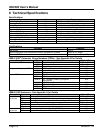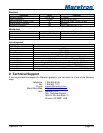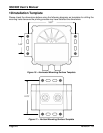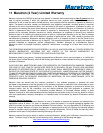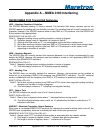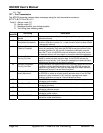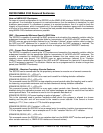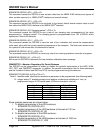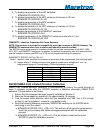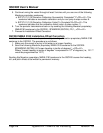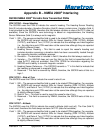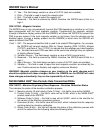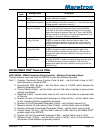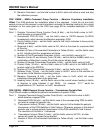
Revision 1.8 Appendix A – NMEA 0183 Interfacing Page A3
®®
SSC200 NMEA 0183 Received Sentences
Note on NMEA 0183 Checksums
For ease of manual configuration of the SSC200 via the NMEA 0183 Interface, NMEA 0183 checksums
are optional. If no checksum is present in a received sentence, then the sentence is treated as if a valid
checksum were present. If a checksum is present in a received sentence, then it is used to check the
integrity of the sentence, which is accepted only if the calculated checksum agrees with the checksum
at the end of the received sentence. To ensure the best possible data integrity, Maretron recommends
using NMEA 0183 checksums whenever possible.
RMC – Recommended Minimum Specific GNSS Data
The SSC200 is capable of receiving the RMC sentence and extracting the magnetic variation data for
subsequent insertion into the appropriate fields for transmission of the HDG and HDT sentences. The
SSC200 uses an aging technique (referred to as “Variation Lifetime”) where variation data is output in
the HDG and HDT sentences for a period of 5 seconds after the RMC sentence is received. The
Variation Lifetime can be re-programmed to a shorter or longer period (see PMARSETP sentence).
VTG – Course Over Ground and Ground Speed
The SSC200 is capable of receiving the VTG sentence and computing the magnetic variation data for
subsequent insertion into the appropriate fields for transmission of the HDG and HDT sentences. The
variation is computed by observing the difference between the true course over ground and the
magnetic course over ground. The SSC200 uses an aging technique (referred to as “Variation
Lifetime”) where variation data is output in the HDG and HDT sentences for a period of 5 seconds after
the VTG sentence is received. The Variation Lifetime can be re-programmed to a shorter or longer time
period (see PMARSETP sentence).
PMAREXE – Maretron Proprietary Execute Sentence
The SSC200 can be commanded via this proprietary sentence to execute one of several commands.
$PMAREXE,SSC200,,F0,,,,<CR><LF>
This command causes the SSC200 to be reset and is useful for initiating deviation calibration.
$PMAREXE,SSC200,,FD,0,,,<CR><LF>
This command causes the SSC200 to stop outputting normal periodic data (like heading) and is useful
for observing non-periodic sentences such as status sentences during deviation calibration.
$PMAREXE,SSC200,,FD,1,,,<CR><LF>
This command causes the SSC200 to once again output periodic data. Normally, periodic data is
disabled during the calibration process such that status messages are easy to see and not lost within
normal periodic data. This sentence is used to turn the periodic data back on.
$PMAREXE,SSC200,,24,”known heading in tenths of degrees”,,,<CR><LF>
This is the command used to perform installation-offset where the compass is aligned to a known
heading and the pitch and roll are zeroed to the vesse’ls current attitude. If the current or known
heading is 177.0°, then a value of 1770 should be programmed.
$PMAREXE,SSC200,,5D,0,”variation”,,<CR><LF>
This command causes the SSC200 to use a manual entry for variation (variation is programmed using
1/10 of a degree resolution – as an example use 2.3 in the “variation” field for a 2.3° variation.
$PMAREXE,SSC200,,5D,1,,,<CR><LF>
This command causes the SSC200 to use variation data from the NMEA 2000
®
interface and ignore all
other variation sources (i.e., NMEA 0183 interface and manual entries).



